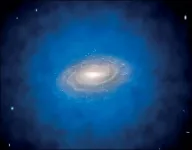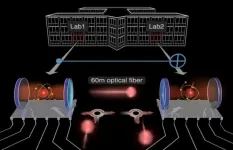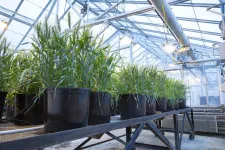New study suggests supermassive black holes could form from dark matter
2021-02-24
(Press-News.org) A new theoretical study has proposed a novel mechanism for the creation of supermassive black holes from dark matter. The international team find that rather than the conventional formation scenarios involving 'normal' matter, supermassive black holes could instead form directly from dark matter in high density regions in the centres of galaxies. The result has key implications for cosmology in the early Universe, and is published in Monthly Notices of the Royal Astronomical Society.
Exactly how supermassive black holes initially formed is one of the biggest problems in the study of galaxy evolution today. Supermassive black holes have been observed as early as 800 million years after the Big Bang, and how they could grow so quickly remains unexplained.
Standard formation models involve normal baryonic matter - the atoms and elements that that make up stars, planets, and all visible objects - collapsing under gravity to form black holes, which then grow over time. However the new work investigates the potential existence of stable galactic cores made of dark matter, and surrounded by a diluted dark matter halo, finding that the centres of these structures could become so concentrated that they could also collapse into supermassive black holes once a critical threshold is reached.
According to the model this could have happened much more quickly than other proposed formation mechanisms, and would have allowed supermassive black holes in the early Universe to form before the galaxies they inhabit, contrary to current understanding.
Carlos R. Argüelles, the researcher at Universidad Nacional de La Plata and ICRANet who led the investigation comments: "This new formation scenario may offer a natural explanation for how supermassive black holes formed in the early Universe, without requiring prior star formation or needing to invoke seed black holes with unrealistic accretion rates."
Another intriguing consequence of the new model is that the critical mass for collapse into a black hole might not be reached for smaller dark matter halos, for example those surrounding some dwarf galaxies. The authors suggest that this then might leave smaller dwarf galaxies with a central dark matter nucleus rather than the expected black hole. Such a dark matter core could still mimic the gravitational signatures of a conventional central black hole, whilst the dark matter outer halo could also explain the observed galaxy rotation curves.
"This model shows how dark matter haloes could harbour dense concentrations at their centres, which may play a crucial role in helping to understand the formation of supermassive black holes," added Carlos.
"Here we've proven for the first time that such core-halo dark matter distributions can indeed form in a cosmological framework, and remain stable for the lifetime of the Universe."
The authors hope that further studies will shed more light on supermassive black hole formation in the very earliest days of our Universe, as well as investigating whether the centres of non-active galaxies, including our own Milky Way, may play host to these dense dark matter cores.
INFORMATION:
[Attachments] See images for this press release:

ELSE PRESS RELEASES FROM THIS DATE:
2021-02-24
A German-Polish research team has succeeded in creating a micrometer-sized space-time crystal consisting of magnons at room temperature. With the help of the scanning transmission X-ray microscope Maxymus at Bessy II at Helmholtz Zentrum Berlin, they were able to film the recurring periodic magnetization structure in a crystal. Published in the Physical Review Letters, the research project was a collaboration between scientists from the Max Planck Institute for Intelligent Systems in Stuttgart, Germany, the Adam Mickiewicz University and the Polish Academy of Sciences in Pozna? in Poland.
Order in space and a periodicity in time
A crystal is a solid whose atoms or molecules are regularly arranged in a particular structure. If one looks at the arrangement with a microscope, one discovers ...
2021-02-24
Today's quantum computers contain up to several dozen memory and processing units, the so-called qubits. Severin Daiss, Stefan Langenfeld, and colleagues from the Max Planck Institute of Quantum Optics in Garching have successfully interconnected two such qubits located in different labs to a distributed quantum computer by linking the qubits with a 60-meter-long optical fiber. Over such a distance they realized a quantum-logic gate - the basic building block of a quantum computer. It makes the system the worldwide first prototype of a distributed quantum computer.
The limitations of previous qubit architectures
Quantum ...
2021-02-24
A new study, published today in Nature Digital Medicine, found that 'natural language processing' (NLP) of information routinely recorded by doctors - as part of patients' electronic health records - reveal vital trends that could help clinical teams forecast and plan for surges in patients.
The researchers from King's College London, King's College Hospital NHS Foundation Trust (KCH), and Guy's and St Thomas' Hospital NHS Foundation Trust (GSTT), used NLP algorithms to translate the electronic notes made by doctors into a standardised, structured set of medical terms that could be analysed by a computer.
Tracking trends in patients
In the ...
2021-02-24
Social distancing - from mobility restrictions to complete lockdowns -- can take many weeks, possibly even months, a potentially devastating outcome for social and economic stability. One of the challenges is that the sick cannot be selectively isolated, since many of the spreaders remain pre-symptomatic for a period ranging from several days to as much as two weeks - invisible spreaders who continue to be socially active. Hence, it seems that without a population-wide lockdown isolating the carriers cannot be achieved effectively.
To bypass this challenge, researchers from Israel's Bar-Ilan University, led by Prof. Baruch Barzel, devised a strategy based on alternating lockdowns: first splitting the population into two groups, then ...
2021-02-24
LOGAN, UTAH -- One solution to agriculture's many challenges -- climate change-induced drought, less arable land, and decreased water quality, to name a few -- is to develop smarter fertilizers. Such fertilizers would aim not only to nourish the plant but also to maximize soil bacteria's positive effects on the plant. Tapping into a plant's microbiome may be the extra layer of defense crops need to thrive.
In their study published on Dec. 4 in Nature: Scientific Reports, researchers at Utah State University analyzed the effects of two abiotic stressors on Pseudomonas chlororaphis O6 (PcO6), a health-promoting bacterium native ...
2021-02-24
URBANA, Ill. ¬- In today's global economy, production of goods depends on inputs from many trade partners around the world. Companies and governments need a deeper understanding of the global value chain to reduce costs, maintain a profitable production system, and anticipate ripple effects of disruptions in the supply chain.
Applied economists from the University of Illinois have developed a new model for in-depth analysis of global supply chain linkages across countries and industries, providing a rich tool that delivers valuable insights for businesses and policy makers around the world.
"We live in a time when production processes are very much fragmented. In order to end up with one type of ...
2021-02-24
Researchers have developed a method to estimate the value of oyster and clam aquaculture to nitrogen reduction in a coastal community. Nitrogen is a nutrient that comes from many different sources, including agriculture, fertilizers, septic systems, and treated wastewater. In excess it fuels algal growth, which can affect water quality and human health.
As a result, a growing number of communities are required to follow regulations to reduce the amount of nitrogen they release. Shellfish are an option that can be a valuable part of a community's nutrient management plan.
In a study in Environmental Science ...
2021-02-24
A UNSW Sydney-led medical research team has called for a new vaccine, improved strategies and enhanced monitoring to combat serious complications from childhood pneumonia.
The researchers examined the impact of the 13-valent pneumococcal conjugate vaccine (13vPCV) on childhood pneumonia and empyema - complicated pneumonia - after its introduction to the Australian National Immunisation Program about a decade ago.
The new study, published in Thorax recently, found that while 13vPCV resulted in a 21 per cent decrease in childhood pneumonia hospitalisations, there was a contemporaneous 25 per cent increase in admissions for empyema.
This incidence data for childhood empyema hospitalisations is similar to that reported ...
2021-02-24
For many, 2020 was notorious for the COVID-19 pandemic, but for climate scientists, the year is also infamous for tying with 2016 as the hottest since records began. 'Nine of the warmest years on record have occurred since 2010', says JEB Editor-in-Chief, Craig Franklin. With the ice caps and glaciers melting, devastating bushfires scorching arid regions, and hurricanes and typhoons battering coastal communities, the impact on local ecosystems has been catastrophic. 'Physiologists can play a critical role in the conversation around climate change', says ...
2021-02-24
As part of the Journal of Experimental Biology's Special Issue dedicated to climate change, Anthony Pagano (San Diego Zoo Global, USA) and Terrie Williams (University of California, Santa Cruz, USA), discuss the impact of environmental change on two iconic polar species; the polar bear and narwhal. Their review article is published in Journal of Experimental Biology at https://jeb.biologists.org/content/224/Suppl_1.
Mammals in the Polar Regions face an uncertain future as unprecedented warming drives catastrophic sea ice loss, driving polar bears onto land, after losing access to sea ice and ...
LAST 30 PRESS RELEASES:
[Press-News.org] New study suggests supermassive black holes could form from dark matter



